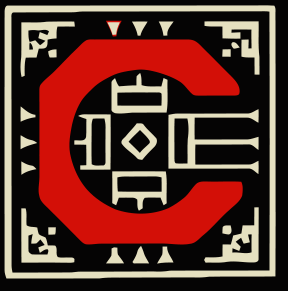Blue Horse (Lakota leader)
| Blue Horse | |
|---|---|
| Sunka Wakan | |
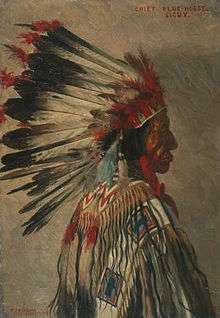 Blue horse painted by Elbridge Ayer Burbank, 1898. | |
| Oglala Lakota leader | |
| Personal details | |
| Born | c. 1822 |
| Died |
July 16, 1908 (age 86-87) Pine Ridge Indian Reservation |
| Spouse(s) | Council Fire Woman |
| Relations |
Red Cloud (adopted brother) Big Mouth (twin brother) |
| Children |
Baldwin Blue Horse (son) Jennie Blue Horse (daughter) Lizzie Blue Horse (daughter) |
| Parents |
Old Chief Smoke (father) Burnt Her Woman (mother) |
'Blue Horse (Oglala Lakota: (Šúŋkawakȟáŋ Tȟó in Standard Lakota Orthography) (1822—July 16, 1908) was a leader of the Wágluȟe Band of Oglala Lakota, warrior, statesman and educator. Blue Horse is notable in American history as one of the first Oglala Lakota United States Army Indian Scouts and signatory of the Treaty of Fort Laramie in 1868.
Blue Horse was known for a willingness to rescue white men in distress and the iconic one-eyed chief was popular subject for portraitists. Blue Horse's life chronicles the history of the Oglala Lakota through the 19th and early 20th centuries. Blue Horse and his adopted brother Red Cloud fought for over 50 years to deflect the worst effects of white rule; feed, clothe and educate their people and preserve sacred Oglala Lakota land and heritage.
Early life
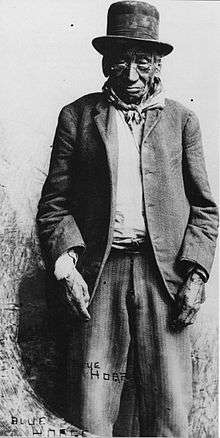
Blue Horse was the second son of Old Chief Smoke and Burnt Her Woman, and the twin brother of Big Mouth.
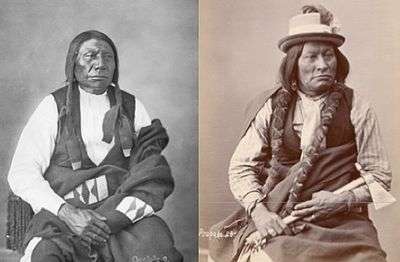
Red Cloud was the adopted brother of Blue Horse. Red Cloud was adopted by Old Chief Smoke, his maternal uncle, around 1825 at the age of three after Red Cloud’s parents died. Blue Horse and Red Cloud were raised as brothers and mentored by Old Chief Smoke. As a young warrior, Blue Horse led war parties with Red Cloud against the Ute, Shoshone, Bannock, Arikara, Crow, Omaha, Pawnee and Piegan.[1]
Old Chief Smoke had five wives who bore him many children.[2] Old Chief Smoke’s sons carried the Smoke People legacy of leadership in Oglala Lakota culture into the 20th century. The children of Old Chief Smoke were Spotted Horse Woman, Big Mouth (1822-1869), Blue Horse (1822-1908), Red Cloud (1822-1909), American Horse, the elder (1830-1876), Bull Bear III, Solomon Smoke II, No Neck and Woman Dress (1846-1920).
Blue Horse married Council Fire Woman (Peta Ominiciye) and had one son Baldwin ("Bali") Blue Horse (Little Medicine) and two daughters, Jennie Blue Horse and Lizzie Blue Horse.
Wágluȟe Band of the Oglala Lakota
The Wágluȟe Band is one of the seven bands of the Oglala Lakota.[3] The Wágluȟe Band is also known as the Loafer Band. The Lakota word Wágluȟe means "One who lives with his relatives (as a hanger-on)" and was used to refer to those who stayed near military forts, their daughters having married soldiers.[4]
Old Chief Smoke
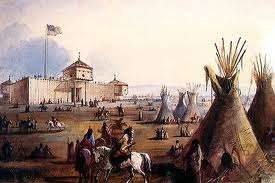
Old Chief Smoke was an Oglala Lakota head chief and one of the last great Shirt Wearers, a highly prestigious Lakota warrior society. The Smoke People were one of the most prominent Lakota families of the 18th and 19th centuries. Old Chief Smoke was one of the first Lakota leaders to appreciate the power of the whites and the need for association. In 1849, Old Chief Smoke moved his Wágluȟe camp to Fort Laramie when the U.S. Army first garrisoned the old trading post to protect and supply wagon trains of white migrants along the Oregon Trail. Lakota families from other camps who preferred the safety of Ft. Laramie joined Smoke’s camp. Old Chief Smoke was aware of the power of the whites, their overwhelming numbers and the futility of war. Old Chief Smoke observed and learned the customs of the whites. By the late 1850s, some Lakota from the wild buffalo-hunting camps began to disparage Old Chief Smoke’s camp at Ft. Laramie and call Old Chief Smoke’s community Wágluȟe (Loafers), meaning they were like men who lived with their wives’ relatives, that is, hangers-on, loafers. On the other hand, some Wágluȟe thought of the Lakota in the wilds as county bumpkins.[5] During the increasing strife of the 1860s, the Ft. Laramie took on a military posture and was the primary staging ground for the U.S. Army during Red Cloud’s War. In 1864, Old Chief Smoke died and was placed on a scaffold near sight of his Ft. Laramie and replaced by Chief Big Mouth.
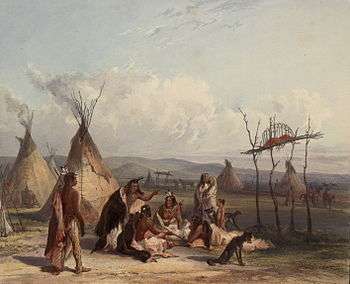
Wágluȟe at Ft. Laramie
The Wágluȟe were aware of the power of the whites, their overwhelming numbers and the futility of war. Traditionally, in intertribal warfare, a fight among fifty warriors in which two men were killed was considered a big fight.[6] The Wágluȟe at Ft. Laramie heard of the 50,000 casualties of the three-day Battle at Gettysburg in July 1863, and knew what white men meant when they spoke of battle. The Wágluȟe observed and learned the customs of the whites. Wágluȟe were considered by the U.S. Army and Indian agents to be the most progressive band of Lakota and many became Indian Police, U.S. Army Indian Scouts with the U.S. 4th Cavalry Regiment from Ft. Laramie and intermediaries with other bands of Lakotas. The Wágluȟe formed a civil administration at Ft. Laramie, and Old Chief Smoke appointed Blue Horse and Big Mouth the first Indian Police officers. The Wágluȟe were first Oglala Lakota to send their children to the Carlisle Indian Industrial School in Carlisle, Pennsylvania, for a formal education. Wágluȟe U.S. Army Indian Scouts were a “Band of Brothers” with U.S. Army Cavalry Scouts and later were the first Oglala Lakota to travel with Col. William "Buffalo Bill" Cody and his Wild West throughout the U.S. and Europe.
Wágluȟe politics
Some Wágluȟe went north to the Powder River Country to fight in Red Cloud's War and became closely tied to militant Miniconjou, Sans Arc and Hunkpappa.[7] Other Wágluȟe supplied food and munitions to Red Cloud. All Wágluȟe respected Red Cloud. The U.S. Army concluded that, even if there were doubts about their reliability, the Wágluȟe’s role as scouts, civil administrators and mediators was absolutely essential.
Blue Horse and Red Cloud
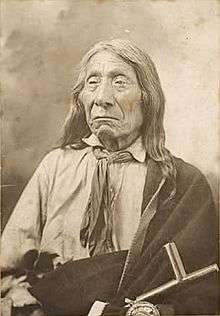
Blue Horse and Red Cloud were warriors, statesmen and leaders of the Oglala Lakota for over 50 years. Their special lifelong relationship chronicles the history of the Oglala Lakota through the 19th and early 20th centuries. Blue Horse and Red Cloud fought to deflect the worst effects of white rule; feed, clothe and educate their people and preserve sacred Oglala Lakota land and heritage.
The Old Chief Bull Bear incident
In 1841, Blue Horse was shot in the back with an arrow during a skirmish with the followers of Old Chief Bull Bear, a challenger to his father Old Chief Smoke. Old Chief Bull Bear contemptuously threw dust in the face Old Chief Smoke and challenged to him to a fight. After the Old Chief Smoke refused, Old Chief Bull Bear killed Old Chief Smoke’s favorite horse. Red Cloud, Old Chief Smoke’s adopted son, sought revenge, and later during a fight with Old Chief Bull Bear’s band killed old Chief Bull Bear. Blue Horse, who was with Red Cloud, was wounded during the incident.[8] The Old Chief Bull Bear Incident was significant in Oglala Lakota history and resulted in the splitting of the bands.[9] Nevertheless, Old Chief Smoke adopted Old Chief Bull Bear’s son, Young Bull Bear, and raised him in the Smoke household.[10]
U.S. Army Indian Scout
Blue Horse began service with the U.S. Army at Ft. Laramie, Wyoming, as early as 1854 when General William S. Harney arrived at the onset of the Sioux Wars. Prior to 1866, Indian scouts were considered employees rather than soldiers, and on July 28, 1866 by an Act of Congress, Indian Scouts were enlisted and paid the salary and allowances as U.S. Cavalry soldiers. Blue Horse was one of the first U.S. Army Indian Scouts formally recruited at Fort Laramie around 1866 and had an excellent reputation with the U.S. Army and white traders as a reliable Indian. Blue Horse maintained the trust of General Harney and Red Cloud, and served as a messenger and intermediary during Red Cloud's War 1866-1868.
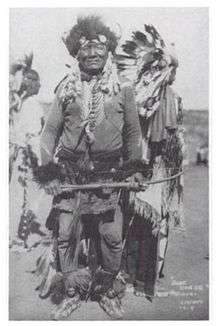
Red Cloud's War
The Bozeman Trail
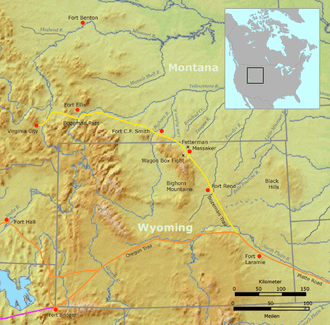
Red Cloud's War (1866-1868), also known as the “Bozeman War” or the “Powder River War”, was an armed conflict after the end of the American Civil War involving the Lakota, Northern Cheyenne, and Arapaho against the U.S. government in Wyoming Territory and Montana Territory. The Bozeman Trail through the Powder River Country was used by an increasing number of miners, emigrant settlers and others who competed with the Cheyenne and Lakota for resources and encroached on their traditional territory to reach gold fields discovered in Montana around 1863. The Powder River Country was the last unspoiled hunting ground of the Cheyenne and various bands of the Lakota. In late spring 1866, the U.S. government called for a council with the Lakota and Northern Cheyenne at Fort Laramie to discuss a treaty to gain a safe passage for emigrant settlers through the Powder River Country and construct forts along the trail. On June 5, 1866, Red Cloud appeared at Ft. Laramie with a thousand warriors to attend the council, and was outraged to learn that the U.S. Army was bringing in troops to construct forts before the Lakota had agreed to a military road through the area. Red Cloud refused to sign a treaty and left the council in protest, and promising resistance to any whites who sought to use the trail or to occupy the Powder River Country. Red Cloud scolded the Peace Commissioner for treating the Indians like children. “The white men have crowded the Indians back year by year, until we are forced to live in a small country North of the Platte. And now our last hunting ground, the home of the people, is to be taken from us. Our women and children will starve, but for my part I prefer to die fighting rather than of starvation. Great Father sends presents and wants a new road. But white chief goes with soldiers to steal road before Indian says yes or no.” “Chief Red Cloud strode past Colonel Henry B. Carrington, and before dawn next day, the Oglala Lakota were gone from Ft. Laramie.” Despite Red Cloud’s warnings, Colonel Carrington marched into the Powder River Country with 750 men and garrisoned forts along the Bozeman Trail. One of the new garrison posts was Fort Phil Kearny, a flash point with Red Cloud. Fort Kearny was known to the Indians as the "hated post on the Little Piney."[12] In response, by late summer Red Cloud had recruited a force of approximately three thousand Oglala Lakota, Northern Cheyenne and Arapaho warriors to oppose U.S. military expansion. The majority of warriors had only bows and arrows and a small arsenal of rifles and ammunition smuggled by Wágluȟe from Ft. Laramie. Red Cloud's warriors soon strategically attacked supply trains and closed the trail. Carrington, a lawyer who made forts with no combat experience, was logistically unable to provide escorts to whites on the trail or to engage in aggressive operations. Carrington respected the fighting ability of Red Cloud, his better knowledge of the terrain and superior numbers. Carrington was in trouble. Red Cloud and the Lakota, Northern Cheyenne and Arapaho were for preparing for battle.
The Fetterman Fight
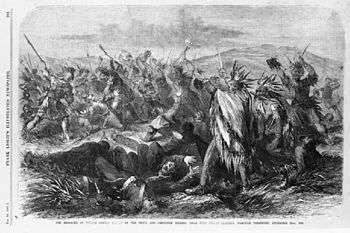
Captain William J. Fetterman arrived at Ft. Phil Kearny, Wyoming, from Ft. Laramie, Wyoming, in November 1866. While Captain Fetterman had extensive combat experience during the American Civil War, he had no experience fighting American Indians. Fetterman criticized Colonel Carrington's strategy and allegedly boasted that “given 80 men he would ride through the Great Sioux Nation." Junior officers at Ft. Phil Kearny were anxious for battle, believed the Indians could be easily defeated and criticized Carrington's apparent unwillingness to fight Indians. On December 21, 1866, a morning supply train to Ft. Phil Kearny was attacked. Fetterman had been sent to chase away a small Indian war party that had attacked a wood party days before and was anxious to go to battle. Colonel Carrington authorized Captain Fetterman to mobilize a detachment of 81 men and gave express orders for Fetterman to stay behind the Lodge Trail Ridge where relief would be difficult. Within a few minutes of departure an Oglala Lakota decoy party led by Crazy Horse appeared on Lodge Trail Ridge. Captain Fetterman disobeyed orders and took the bait after several of the Oglala Lakota warriors stood on their ponies and insultingly waggled their bare buttocks at the troopers. Fetterman followed Crazy Horse’s advance party and raced down and into valley where more than 2,000 Oglala Lakota, Cheyenne and Arapaho were concealed. The ambush killed the entire 81-man U.S.Army detachment, while combined Indian forces suffered only 14 casualties. The incident, known as the "Fetterman Massacre" by the U.S. Army and the "Battle of the Hundred Slain" and the "Fetterman Fight" by Native Americans, involved the highest U.S. Army fatalities in a single event on the Great Plains until the disaster of the Battle of Little Big Horn nearly ten years later. General Philip St. George Cooke held Carrington solely responsible for the defeat and relieved him of command on December 26, 1866. Big Mouth and his party was dispatched by General William S.H arney and returned on January 16, 1867, after spreading news that fine gifts awaited warrior chiefs if they came into Ft. Laramie to sign new treaties. General Ulysses S. Grant, commanding the U.S. Army, moved to court-martial Carrington, but at the suggestion of General William Tecumseh Sherman submitted the matter to a court of inquiry which subsequently exonerated Carrington, as did a separate investigation by the United States Department of the Interior.[13]
The Fetterman response
Public shock following the incident resulted in reassessment of the government's Indian policy, and a U.S. Peace Commission toured the Great Plains in 1867 to gather information to help bring about peace among the tribes and with the U.S. The Commission concluded Native Americans had been provoked by white encroachment and competition for resources and recommended assigning definite territories to the Great Plains tribes. In late summer 1867, the U.S. government changed its policy and decided to use the First Transcontinental Railroad to transport immigrants. The government decided that a military presence in the Powder River Country was too expensive and unproductive and agreed to abandon its forts and withdraw completely from Lakota territory.
Intermediary to Red Cloud
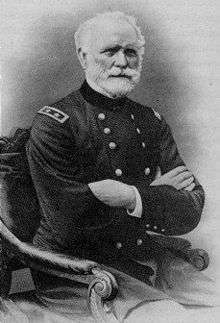
Red Cloud did not participate in the Fetterman Fight. Rather, Red Cloud was with Blue Horse who had carried tobacco from General Harney at Ft. Laramie inviting Red Cloud and the Northern Oglala leadership to talks at the fort. The reaction was negative, with the tobacco packages thrown in the fire by angry warriors. Blue Horse remained in the Red Cloud's village for several days at the time of the Fetterman Fight. Blue Horse's return to Ft. Laramie with intelligence is noted in reports of the Upper Platte Indian Agency and accounts by Lakota eyewitnesses. Chief Blue Horse, Chief Big Mouth and other Wágluȟe acted as intermediaries throughout Red Cloud’s War.
Treaty of Ft. Laramie 1868

Blue Horse and Red Cloud were a signatories to the Treaty of Fort Laramie in 1868. The treaty was an agreement between the United States and the Lakota Nation guaranteeing the Lakota ownership of the Black Hills and land and hunting rights in South Dakota, Wyoming and Montana. The Powder River Country was to be henceforth closed to all whites. The Treaty ended Red Cloud's War. In the Spring of 1868, U.S. peace commissioners were sent to Fort Laramie. The Treaty of Fort Laramie declared the Powder River Country "unceded territory" to be used as a reserve for Cheyenne and Lakota. The treaty also established the Great Sioux Reservation, including the Black Hills and covering the territory of West River, west of the Missouri River in present-day Nebraska, and including parts of South Dakota. On April 29, 1868, Spotted Tail and other Brulé leaders "touched the pen." On May 25, 1868, many Lakota leaders including Sitting Bull, Man-Afraid-of-His-Horses and American Horse signed. The Northern Cheyenne and Arapaho also signed.
However, Red Cloud refused to meet with U.S. peace commissioners until the U.S. Army abandoned Fort Phil Kearny and other the Powder River Country forts. In August 1868, Red Cloud's demands were met and the Powder River Country forts were abandoned and the garrisons removed to Ft. Laramie. On November 6, 1868, Red Cloud signed the Treaty of Fort Laramie with Father Pierre-Jean De Smet as a witness.
Red Cloud's victory
The Treaty of Fort Laramie was regarded as a great victory for Red Cloud, who defeated the U.S. Army in battle. The U.S. Army Powder River Country forts were abandoned and the hunting grounds of the Lakota, Cheyenne and Arapaho had been protected. In addition, the treaty required the U.S. government to issue weekly rations and subsidies to the Oglala Lakota.[14]
The murder of Big Mouth
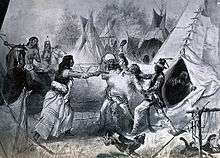
Blue Horse’s twin brother Big Mouth was the elder and became head chief in 1864 upon the death of Old Chief Smoke. Big Mouth opposed Spotted Tail’s leadership and criticized his negotiations with Washington politicians. On October 29, 1869, Spotted Tail called at the door of Big Mouth’s lodge, and asked to speak with him. On his appearance, he was seized by two warriors, who held him fast, while Spotted Tail drew a pistol, placed it against his body, and shot Big Mouth dead.
Captain DeWitt C. Poole at the Whetstone Indian Agency reported Blue Horse’s shock and anger to Big Mouth’s murder. “Blue Horse started a violent harangue in the Sioux language. He had a rifle in one hand and a strung bow and a bunch of arrows in the other, and when he dropped his blanket, two navy Colts and a big scalping knife could be seen in their sheaths at his belt. He was in a raving fury, leaping and bounding about the room as he hurled accusations and threats at Spotted Tail. Big Mouth died toward dawn. Some hours later, Blue Horse came to agent Poole’s office and told he that he felt so sad over the death of his great and good brother that he would have to wash off the paint he had put on his face for the feast the day before and begin mourning. The interpreter warned Poole that if this Indian washed his face and started mourning, it would mean the reopening of the feud and more shootings. The agent would give Blue Horse two blankets, that would comfort him, and he would refrain from washing his face and going gunning for Spotted Tail. The blankets were handed over, and the grieving brother went quietly away.”[15] Poole later reported that Spotted Tail made a prompt payment of a stipulated number of ponies to Blue Horse and that aboriginal law had been vindicated.[16]
Blue Horse was pressed to avenge the murder of Big Mouth, but chose the path of non-violence and instead moved with his Wágluȟe Band to another locality. Red Cloud was also aggrieved by his brother's murder. Nonetheless, Red Cloud continued to work with Spotted Tail in delegations to Washington, D.C. to protect tribal lands, enforce broken treaties and preserve Lakota culture.
Delegations to Washington
In 1872, Blue Horse accompanied Red Cloud and a Lakota delegation to Washington, D.C. to meet with President Ulysses S. Grant. Waiting decision from President Grant on continued negotiations, Red Cloud and Blue Horse toured New York City. The New York Herald reported the gala event:
- “During the late visit of Red Cloud and his party to New York, they went to the Olympic Theater to witness the funny pantomime of Humpty Dumpty. The Herald says: They stalked into the theater cool as a cucumber, and took orchestra chairs without saying a word.... The wild Indian is a stolid being naturally. He does not believe in manifesting astonishment or surprise at anything, but the ballet was too much for their gravity. Before Blue Horse was half an hour in the theater he had fallen desperately in love with a shapely girl who performed as a coryphee in the ballet. This young lady saw the affection beaming visibly out of the eyes of Blue Horse, and it touched her heart so deeply that she jumped three times as high in every movement as her salary would permit.”
Blue Horse's opposition to the Oglala Census of 1874
In November 1873, Dr. John J. Saville, superintendent of the Red Cloud Agency, ordered a census of the Oglala to enumerate the agency Indians. The food situation was desperate. Blue Horse and Red Cloud opposed the census knowing the count would result in a loss of rations for the Oglala and resisted threats from the government to withhold food and supplies.[17] “The Cincinnati Commercial thus accounts for the refusal of Red Cloud and Blue Horse to allow a census of their people to be taken. They have probably been told by the missionaries how David was punished by making a count of the Israelites, and have cultivated what may be properly styled a theological prejudice to census statistics. We think however that those chiefs theological objections are more like to relate to the Book of Cincinnati Numbers, as they don’t want their numbered inferiority made public."[18] Saville's disagreements with Blue Horse and Red Cloud eventually led to a Commission to investigate alleged mismanagement at the Red Cloud Agency and recommend that Saville be removed. Dr. Saville resigned in 1875.[19]
Letter to President Grant
On June 5, 1875, the Anglo-American Times published a letter written by Blue Horse to President Grant. “The President has received letters from Sioux chiefs unable to accompany the delegation, of which the following from Blue Horse may be taken as a sample: ‘There are fifty families of my people who wish to go to farming. We wish to go to work and do not want white men to run over us. We intend to remain here and we want neat houses and fences and everything that the white men use. We want a cow, two yoke of oxen of oxen, and a wagon, also chickens. Whatever the President may give those who visit Washington, I wish a share also. I also want a sewing machine and other farming implements. The Great Father has promised us that we should not starve, and I wish to make a living for myself on these rivers in this way.'”
Battle of the Little Big Horn
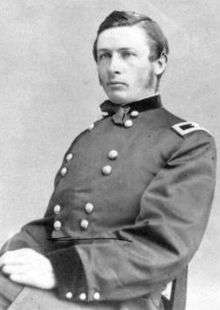
After the Battle of the Little Bighorn in late June 1876, the government took punitive actions including disbanding U.S. Army Indian Scouts, clamping down on the agency bands and taking a census creating considerable unrest. On August 31, 1876, Blue Horse was arrested for a short time by General Ranald S. Mackenzie for not turning in northern “hostile” Indians slipping into his Loafer village.[20] Blue Horse continued to serve as an intermediary to Red Cloud after the Battle of the Little Big Horn.[21]
New Wágluȟe leaders

After the Battle of Little Big Horn and the arrest of Blue Horse, the Wágluȟe split into three bands. Blue Horse remained leader of one band, and rising young leaders American Horse and Three Bears led the other two. Red Shirt was also a popular leader and served as Three Bears’ lieutenant. These leaders had much in common. Blue Horse, American Horse, Three Bears and Red Shirt all served as U.S. Army Indian Scouts with the U.S. 4th Cavalry Regiment from Ft. Laramie led Lakota delegations to Washington, D.C., their children attended the first class at the Carlisle Indian Industrial School in Carlisle, Pennsylvania and joined with Buffalo Bill’s Wild West. Wágluȟe U.S. Army Indian Scouts from the Pine Ridge Agency, South Dakota, were a “Band of Brothers” with U.S. Army Cavalry Scouts and the first Oglala Lakota to travel with Col. William Frederick "Buffalo Bill" Cody and his Wild West throughout the U.S. and Europe. Veterans from the Great Plains Wars chose to offer their services to Colonel "Buffalo Bill" Cody and appreciated that Wild West shows preserved Oglala Lakota heritage during a time when the Bureau of Indian Affairs was intent on promoting Native American assimilation.
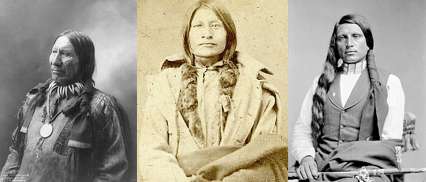
Blue Horse's eye
In 1883, Blue Horse received national news coverage when the Bureau of Indian Affairs released his letter to the Great Father President Chester A. Arthur respectfully requesting a glass eye. The newspaper accounts of his letter were supportive. “Blue Horse, a good hearted Sioux, respectfully writes President Arthur to send him a glass eye, brown to match the sound one. Blue Horse compares very favorable with the many requests of his white brethren who make requests of the President.” Another paper reported:
- “As an instance of the progress being made in the civilization of the Indian the Department publishes a letter received not long ago from a Sioux, named Blue Horse, asking the authorities to oblige him with the gift of a glass eye. He naively states the being desirous of adopting the customs of the pale-faces, and noticing the white man splitting wood for his squaw, he thought he would follow suit. But not being adept at the art of splitting would, a piece flew up and ‘hit him in the eye' putting it out. Hence his request. He incidentally mentions that he would like to have a brown eye to match the other optic. We hope the Great Father or his representative will grant the request of this child of nature. He may then properly be termed a ‘bully Blue Horse with a glass eye.” Blue Horse was witty, and when artist Elbridge Ayer Burbank asked about his request to the Great Father in Washington for a glass eye, Blue Horse responded, "he did not want a glass eye, but a good eye he could use." "While he was in the agent's office the carpenter was making a coffin out of a bacon box. Blue Horse told him that when be died he did not want to be buried in a bacon box doubled up, that he wanted a box long enough so he could stretch his legs if necessary.”
Wild Westing with Buffalo Bill

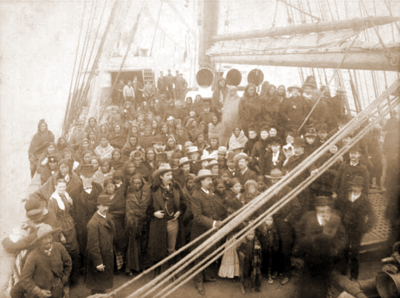
Blue Horse was one of the first Oglala Lakota to go Wild Westing with Buffalo Bill’s Wild West Shows. Blue Horse accompanied Buffalo Bill Cody on the show's first international trip to London, England on March 31, 1887. The show's entourage crossed the Atlantic in the SS State of Nebraska, and included 297 passengers (97 of them Natives), 18 buffalo, 181 horses, 10 elk, 4 donkeys, 5 longhorns (Texas steers), 2 deer and 10 mules. Buffalo Bill's Wild West Show was part of the celebration during the Golden Jubilee of Queen Victoria at Windsor Castle in England, and toured through Birmingham, Salford, and London for five months. The London Courier reported Blue Horse and companions treated to an evening of English hospitality. “Willesden was as it were taken by storm on Sunday last, being invaded by the Indian contingent of Buffalo Bill’s Wild West Show. The fact was that Mr. T.B. Jones, of the White Hart Hotel had, as another instance of his great geniality, invited Red Shirt, Blue Horse, Little Bull, Little Chief and Flies Above and about twenty others to an outing to his well-known hostelry, whereabout they might enjoy his bounteous hospitality. In carriage and brake, provided by mine host, these celebrated chiefs, along with their swarthy companions, with faces painted gaily, bedizened and bedangled with feathers and ornaments, and clad in their picturesque garments, accompanied by their chief interpreter, Broncho Bill and other officials, reached the White Heart about half-past 12 o’clock.”[22] In 1888, Buffalo Bill had a Dinner Party in New York City. “The Hon. Wm. F. Cody, or as he is more familiarly known, ‘Buffalo Bill’, gave a watapee at the ”Wild West” camp yesterday. The affair was graced by a distinguished party of ladies and gentlemen. To watapee is Sioux for “good eat.” Chief Blue Horse was in attendance. “A feature of the repast was rib roast, and the menu also included roast corn, pickles and pumpkin pie.”[23] Buffalo Bill's Wild West Show returned to Europe in 1889-1890 and performed in England, France, Italy, and Germany. Blue Horse traveled with Wild West Shows from 1886 and beyond 1904.
Baldwin Blue Horse
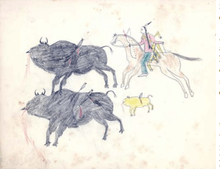
The Carlisle Indian Industrial School in Carlisle, Pennsylvania, was a unique school, and is considered by some Native Americans like going to Yale, Princeton or Cambridge.[24] In 1879, Blue Horse's son Baldwin Blue Horse, age 12, was in the first group of Oglala Lakota students to arrive at the Carlisle. The Carlisle Indian Industrial School was part of the U.S. government's efforts to educate and assimilate Native Americans.[25] In 1888, Blue Horse met with Baldwin Blue Horse at a performance of Buffalo Bill's Wild West in Philadelphia, Pennsylvania. Baldwin ("Bali") could not speak Lakota and Blue Horse could not speak English, and an interpreter was called to enable them to converse.[26]
The Great Sioux Reservation
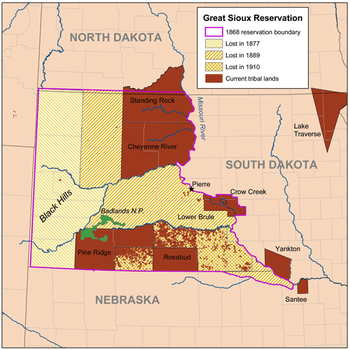
On March 2, 1889, just months before North Dakota and South Dakota were admitted to the Union on November 2, 1889, Congress passed an Act which partitioned the Great Sioux Reservation and created five smaller reservations. Blue Horse, Red Cloud and other Oglala Lakota leaders spoke against the Act and refused to sign the bill. Red Cloud referred to provisions of the Treaty of Fort Laramie (1868), arguing that the terms had not been fulfilled, and that payment for what was due must be made before giving up more land. In response, General George Crook disparaged Red Cloud and threatened that the Indians will be swallowed like little fish by the whites unless they agreed to sign the bill. Red Cloud was enraged and asked the Indians who signed the bill and the Commissioners to leave the reservation. Despite the protests and legal arguments of Oglala Lakota leaders, the Great Sioux Reservation was partitioned.[27]
Wounded Knee
In 1890, there was serious tension at Pine Ridge Agency around the time of the Wounded Knee Massacre. Blue Horse was opposed to the Ghost Dance movement and knew it would bring war and more suffering. Overnight, Pine Ridge Agency had become an armed camp and two twelve-pound cannon were included in the armament. One of the cannon pointed toward the friendly camp of Blue Horse, and Blue Horse sought out Dr. Valentine McGillycuddy, the chief agent of Pine Ridge Agency, to use his influence to have the cannons pointed in another direction. Blue Horse insisted, "There is no trouble in my camp. That big gun might go off and hurt someone." Dr. McGillycuddy went to General John R. Brooke's headquarters and made the request to change the gun position, but General Brooke shrugged off the matter and the cannon remained where it was.
Charles Alexander Eastman

In 1890, Native American historian Charles Alexander Eastman recorded his first meeting with Blue Horse at Pine Ridge Agency, South Dakota. Eastman reported Blue Horse was his “first caller” at the Pine Ridge Agency and Chief Emeritus of the Wágluȟe Band. “He softly opened the door and stepped in without knocking, in characteristic Indian fashion. After greeting me in Sioux, he promptly produced his credentials, which consisted of well-worn papers that had been given him by various high military officers, from General William Selby Harney to General George Crook, and were dated 1854 to 1877. The old man wanted nothing so much as an audience, and the tales of his exploits served to pass the evening." Eastman recorded that “Blue Horse had been, as he claimed, a friend to the white man, for he was one of the first Sioux U.S. Army Indian Scouts, and also one of the first to cross the ocean with Buffalo Bill."
Son of the Shadow-Maker
Elbridge Ayer Burbank
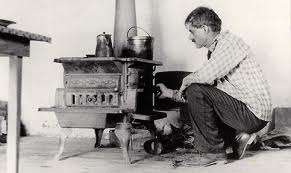
In 1898, Blue Horse became friends with the noted artist Elbridge Ayer (E.A.) Burbank while he was visiting the Pine Ridge Agency. Burbank painted sitting portraits of the greatest Native American leaders, including Geronimo, Sitting Bull, Red Cloud and Chief Joseph. Burbank painted more than 1200 portraits of Native Americans from 125 tribes. At the time, Blue Horse was eighty years of age and rode each day on his horse to pose for Burbank, who he called “Son of the Shadow-Maker.” Burbank was also an historian and his fond recollections illuminate Blue Horse. “Hardly a day passed without Blue Horse coming to my studio to visit me. He would sit down and smoke a little, short, strong pipe and gossip with the other Indians present; all the time he was talking he would be fanning himself with the wing of a turkey. His face usually was painted red, and he wore all the Indian clothes he had, with a single feather on his head. He was a thorough Indian, and extremely kind-hearted. His principal object in life was to try to make others happy around him.” Burbank recorded his stories of Blue Horse.[28]
Lizzie Blue Horse
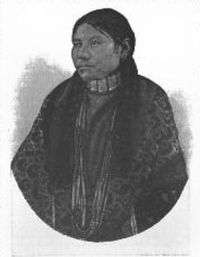
Blue Horse insisted that Burbank paint four portraits of him. After the first one was finished, Blue Horse's daughter Lizzie Blue Horse was very ill and Blue Horse asked Burbank to his house to see her. Burbank found the girl lying on a pile of blankets dying of consumption and did what he could to comfort her and proposed getting a doctor the next day. But in the morning Blue Horse rode in and said that his daughter had died during the night. As soon as the body was buried, Blue Horse had the house torn down. Blue Horse told Burbank that he would go to a place one hundred miles distant to visit with some other Indians and forget his troubles. Blue Horse asked Burbank to lend him seven dollars to buy calico for one of his daughter’s good friends. Burbank told him that he was too poor to buy calico for other people. “Look here, my friend,” said Blue Horse, “I want that calico to give to my daughter’s friend so that my daughter will be happier in heaven. If you will lend me the money I will pay you by posing for you." Burbank agreed and handed him the seven dollars. Blue Horse said his heart was sick and that he wanted to go to Rosebud, about a hundred miles away, where he could see a different country and new faces that would help him to forget as much as possible his grief. Blue Horse pointed to the position of the sun at nine o’clock in the morning. “In one moon I return,” and with his thumb and forefinger Blue Horse made a circle to indicate the sun. Blue Horse returned exactly when he said he would and found Burbank painting the portrait of another subject. The old man pointed his finger at Burbank accusingly. “You lie,” he said. Burbank asked him why. “You promised to finish my picture when I came back.” Burbank explained that he could not wait but that as soon as he had finished the portrait he was working on he would resume his picture. This satisfied Blue Horse, and Burbank painted three more portraits of him.
A cup of coffee
Blue Horse invariably dined with Burbank at noon and always had a good appetite. One day, after dinner, Burbank said to Blue Horse: "I notice that you always eat everything in front of you, but you never pass your plate back the second time or ask for another cup of coffee. Why is that? Is it because you cannot eat any more or drink any more coffee. O, yes, he replied, I could eat more, but I thought the twenty-five cents you paid for my dinner was for just what was placed before me. No, I said, the twenty-five cents pays for all you can eat. Hereafter, if one plate is not enough, ask for more, and drink all the coffee you want. All right, he replied, I will. And be did. I also told him to tell his friends this, and suggested that if any white men sitting at his table left anything to eat on their plates before them, that it would be all right for him to gather it up and take it home for his wife and children. It is needless to say that all the Sioux Indians who patronized that hotel afterward got all that was coming to them.” One time Blue Horse was in the Indian trader's store with his little niece, who saw something on the shelves that she very much wanted. Blue Horse had no money, so he took off his old moccasins and gave them to the Indian trader in exchange for what the little girl craved and he walked home barefooted.
Flypaper bad medicine
Blue Horse came to Burbank's studio one hot day, fanning himself with a big turkey wing. "He sat down on my bed and, not noticing, put his had down on a sheet of sticky flypaper I had placed there. To pull it loose, he grabbed the other end of the flypaper with his other hand, and soon he was tangled up gloriously. Before I could come to his rescue, he had managed to stick the flypaper on his little dog’s back. In no time at all, the pup had dashed around the room, attaching himself to first one object, then another. The situation was funny to everybody but Blue Horse. 'Bad Medicine,' he said in disgust.”
Assiting whites
Chief Blue Horse was known for assisting white men in distress and swore in the presence of the Great Spirit "Wakan Tanka" that his brown hand had never risen to kill a white man. Blue Horse's friend E.A. Burbank reported: “At my hotel in Pine Ridge I chanced to meet a white Indian trader who owned a store about twenty-five miles from the agency. He said that a good many years before a band of Sioux had captured twelve of his comrades and planned to burn them at the stake. Blue Horse, who lived forty miles distant, heard of their intentions and immediately mounted his horse and rode as fast as he could to where the Indians held the whites captive. The trader said he never saw an Indian or a white man work harder than Blue Horse did that day to save the lives of those twelve men, which he was able to accomplish, and from that time on, he said whenever he met Blue Horse he always gave him money and tobacco in recognition of his aid to white men in distress.” Blue Horse’s Wágluȟe village afterward became noted as a place of refuge for white travelers.
Blue Horse's blessing to the son of the Shadow-Maker
“I am now going to leave you, as it were. I hope to meet you again, and I raise my pipe above my head and say, Great Spirit, I pray be good to my friend, the Son of the Shadow-Maker. Toward the pine trees, north, cold winds, treat him kindly toward the rising sun, east, great sun shine on his lodge early every morning toward the place where the Shadow-Maker lives, south, bless your son toward the land of the setting sun, west, waft on the breezes our friend this way. Lowering my pipe of peace, I say, Kind Mother Earth, when you receive my friend into thy maternal bosom, hold him kindly let the howl of the coyote, the roaring of the bears and mountain lions, the cold blasts of winds swaying the tops of the pine trees be a sweet lullaby to him, that shaketh the hand of your friend.”
The last meeting of Blue Horse and son of the Shadow-Maker
“After finishing my work in the north, I returned to Pine Ridge, and Blue Horse hastened to visit me as before. I became very much attached to him. When I left he held my hand in both his and shook it warmly. His heart was too full of emotion to speak a word. He realized that the chances were we would never see each other again. He died several years ago.”
Blue Horse and the Spirits
“The Hunka ceremony was mysterious for the Indians."[29] It was good when the Indians did not know the ways of the white man. It made the Indians like one family. Bad Indians could not become Hunka. It was not the white man’s way of teaching. Sometimes many Indians camped together to perform the ceremony. Then there were good times. This was usually in the summer time. The winter was not a good time for the ceremony, because food was not plenty during the winter. When many Indians gathered together for the ceremony, the old men counseled and the young men played games. The women provided plenty to eat. The children were happy and were never hungry. The young people made lover. Many sought a vision, and talked with the spirits. The good spirits attended such gatherings. The bad spirits also come. The Lakotas here practiced this ceremony for many years. It was not always the same. The shamans first learned how to perform it right. These shamans became Oglalas. The other Lakota learned how to perform it from the Oglalas. Other Indians are Hunkas, but they are not full Hunkas like the Oglalas. The young people do not become Hunka now. It is of no use to them. The old people do not pay attention to the Hunka now. The Hunka are not what they were in old times. Some old Indians could perform the ceremony right. An old Indian who wears the gee string and leggings could perform it. He might be afraid to talk like the Indians did before they lived on a reservation. It would not be right to teach the young Indians what was taught to the Hunka in old times. There are some secret things taught to a Hunka. These secrets are not good now. They are not about the spirits. The spirits will not come now. These are the spirits of the skies of the Earth, of the clouds, of the Thunder, of the land of pines, of the coming light of the sunset of the south, of the winds, of the waters, of flying things, of the beasts, of the insects, and of the spider. There are bad spirits also. There are ghosts and the man from the land of the pines. One spirit is stronger than another. One spirit is chief, and can influence all other spirits. These spirits come no more to the Indians of the reservation. It involved things that would not be allowed now. The Oglala did not think these things were wrong, but the white people do. For example a Hunka was taught how to steal horses and steal women from other Indians than Lakota.”[30] “White men have their Bible and their Christ to guide them to the life to come. We Indians have our White Cow traditions and brave deeds. Let us wait, my friend, and see who gets there first.”[31]
The Pan-American Exposition of 1901
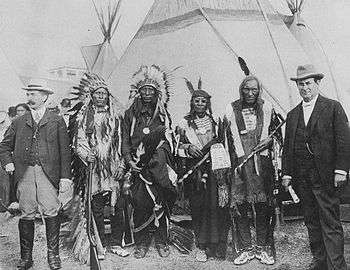
In 1901, Blue Horse attended the Pan-American Exposition, a World’s Fair held in Buffalo, New York, from May 1 through November 2, 1901. Blue Horse was one of the major leaders of Colonel Fred T. Cummins Indian Congress and Wild West Show. Dr. N.W. Wilson, the health officer for the exposition, reported an incident involving Blue Horse and his wife, Council Fire Woman. “One day I found myself suddenly famous among the Indians as a wonder worker fit in rank with the best of their medicine men. The squaw of Blue Horse tumbled over in a faint one afternoon and she was carried into her tepee. The Indians said she was dead. I applied restoratives and in a little while she was alright. Now Blue Horse is a big civil chief in the Sioux Nation, and his wife is of some consequence in Sioux society. So when the Indians saw her come back to life after apparent death, they gave me credit for having worked a miracle. Blue Horse himself believed it and circulated the story.” Blue Horse was so grateful that Dr. Wilson was conferred an honorary degree of medicine man and given the name of “He-Wakes-Them-Up” in a great ceremony at the council house.[32]
The McKinley assassination
The Pan-American Exposition of 1901 is most remembered because President William McKinley was assassinated by an anarchist, Leon Czolgosz, at the Temple of Music on September 6, 1901. McKinley died eight days later. On Sunday morning, September 15, 1901, President McKinley’s casket was closed and the honor guard placed the casket into a hearse. Close behind the followed President Theodore Roosevelt with Secretary Elihu Root and other members of the Cabinet following. The procession moved through a vast throng to the Buffalo City Hall where the body, lying in state, was viewed by one hundred and fifty thousand people. Toward the end of the afternoon, Indians from the exposition, in their blankets and feathers, followed by their squaws filed by. The Indians liked President McKinley and they had come to see the Great Father. A few hours before they had sent a wreath of purple astors accompanied by the inscription: “Farewell of Geronimo, Blue Horse, Flat Iron and Red Shirt and the seven hundred braves of the Cummins Indian Congress and Wild West Show. Like President Lincoln and Garfield, President McKinley never abused authority except on the side of mercy. The martyred Great White Chief will stand in memory next to the Savior of mankind. We loved him living, we love him still.” As the Indians passed, each of them dropped a white carnation upon the President’s coffin.[33]
The Louisiana Purchase Exposition of 1904
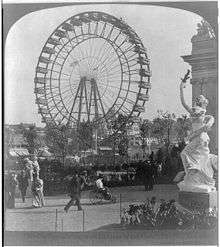
The Louisiana Purchase Exposition, informally known as the "St. Louis World's Fair", was an international exposition held in St. Louis, Missouri, in 1904. Blue Horse joined Colonel Cummins’ Wild West Indian Congress and Rough Riders of the World and made public appearances at the Exposition. Blue Horse regularly rode the giant observation Ferris Wheel, and at age of 82 and to the delight of the crowds, ascended the sky above in a captive air balloon.
Congress of Indian Educators
On January 28, 1904, Blue Horse requested employment as a Show Indian for the St. Louis World’s Fair. Initially, S.M. McCowan of the Department of Anthropology replied to Blue Horse that he had no use for him and that it was not the purpose of the government to expend money bringing large numbers of "old Indians" to the Exposition. McCowan discouraged Indians he did not consider educated from speaking or attending the Congress of Indian Educators and distanced himself from anyone who worked in Wild West Shows. However, McCowan made eventually made exceptions to the best-known Native American orators at the St. Louis World's Fair, Blue Horse and Red Cloud, Oglala Lakota, both eighty-three years old, and they were asked to speak at the 1904 Congress of Indian Educators. Their interpreter was Henry Standing Soldier, an educated man who had been a participant in the 1901 Pan American Exposition Wild West Show. Anthropologists lectured and educated Indians held congresses, while Indian students staged band concerts, dance exhibitions, dramatic presentations and marched in parades.[34]
An indignation meeting
On June 18, 1904, there was an incident when cowboys in the Colonel Cummins’ Wild West Indian Congress and Rough Riders of the World snapped their revolvers in the faces of the Indians as an act of disrespect. “An ‘indignation meeting’ was held by 750 Indians presided over by Blue Horse and Geronimo, and they notified the management that if problems were not addressed vengeance would be handed out.” By September 1904, relations between the Indians and the Cummins Show had much improved.[35]
Final days
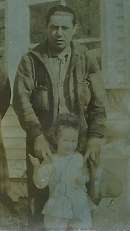
Blue Horse passed to the "Sand Hills" at the Pine Ridge Agency in 1908 at the age of 87. Blue Horse's epitaph was reported by E.A. Burbank in Blue Horse's final letter to the Son of the Shadow-Maker. “If you ever in your travels should meet my Great Father "Wakan Tanka", please ask him to remember Blue Horse.”
Joseph Blue Horse
Joseph Blue Horse, the son of Baldwin Blue Horse, attended the Carlisle Indian Industrial School in Carlisle, Pennsylvania, from November 1916 through August 1918, and was a bugler and a member of the debating society. In August 1918, he was transferred to the Haskell Institute in Lawrence, Kansas, when Carlisle closed. Joseph Blue Horse was a friend of Major Israel McCreight of Du Bois, Pennsylvania, and full time resident of The Wigwam for three years. A veteran of World War I, Blue Horse joined Miller Brothers 101 Ranch and for many years he was billed as “The World’s Champion Rider”. Later, Blue Horse performed as a musician with the show. During his years at The Wigwam, Blue Horse preferred a traditional tipi to a bedroom in the home and was known affectionately as “Teddy”. Joseph Blue Horse assisted McCreight with estate duties and frequently visited local schools talking to children about Oglala Lakota heritage, singing songs and performing stunts.[36]
References
- ↑ Edwin S. Curtis, “The North American Indian: Volume 3, (1908) at p.183.
- ↑ Old Chief Smoke's five wives were Looking Cloud Woman of the Teton Mnikȟówožu, Comes Out Slow Woman of the Teton Oglála, Burnt Her Woman of the Teton Sičháŋǧu, Yellow Haired Woman of the Southern Cheyenne, and Brown Eyes Woman of the Teton Húŋkpapȟa.
- ↑ See Madonna Blue Horse Beard. http://mreid.com/lakota/oyalako.htm
- ↑ See New Lakota Dictionary, http://www.lakotadictionary.org/phpBB3/nldo.php
- ↑ George E. Hyde and Harry H. Anderson, “Spotted Tail's Folk: A History of the Brule Sioux” (1961) at p.117.
- ↑ Stephen Ambrose, “Crazy Horse and Custer: The Parallel Lives of Two American Warriors, (1996) at p.156.
- ↑ Ostler, “The Plains Sioux and U.S. Colonialism from Lewis and Clark to Wounded Knee, (2004) at p.44
- ↑ John H. Monnett, "Where a hundred soldiers were killed: the struggle for the Powder River", p.23 (2008).
- ↑ George E. Hyde," A Sioux Chronicle", University of Oklahoma Press, p.88 (October 1993)
- ↑ James R. Walker, Raymond J. DeMallie, Elaine Jahner, "Lakota Belief and Ritual", Bison Books (May 1, 1991)
- ↑ This may not be a photograph of Blue Horse. Contrary to the notes given the Smithsonian Archives, Red Cloud did not kill Blue Horse's father. He killed Old Chief Bull Bear. The Smithsonian Archive notes state: "Summary: Post card photograph, by Stevens? Full length, standing, front, native dress, holding bow and arrows. Bio/His notes: His father was killed by Red Cloud. Blue Horse was shot in back with arrow. Red Cloud also killed Bull Bear and Standing Soldier. All killed from ambush."
- ↑ Keenan, Jerry; (2000:8) The Wagon Box Fight: An Episode of Red Cloud's War, Savas Publishing. ISBN 1-882810-87-2
- ↑ Dee Brown, “Bury My Heart at Wounded Knee: An Indian and his History of the American West”, “On Red Cloud”, R. Eli Paul,(2009) at p.148-165. Carrington’s successor at Ft. Kearny, was General Wessels, and never launched a major offensive against Red Cloud.
- ↑ The treaty included articles intended to "insure the civilisation" of the Lakota; financial incentives for them to farm land and become competitive - and stipulations that minors should be provided with an "English education" at a "mission building". To this end the US government included in the treaty that white teachers, blacksmiths and a farmer, a miller, a carpenter, an engineer and a government agent should take up residence within the reservation.
- ↑ George E. Hyde and Harry H. Anderson, “Spotted Tail's Folk: A History of the Brule Sioux”, (1961) at p.167-168.
- ↑ Dewitt Clinton Poole, “Among the Sioux of Dakota: eighteen months experience as an Indian agent” (1881) at p.165.
- ↑ Thomas R. Buecker, “Fort Robinsion and the American West, 1874-1899”, (1999) at p.5.
- ↑ Boston Globe, November 21, 1874.
- ↑ "Report of the Special Commission Appointed to Investigate the Affairs of the Red Cloud Indian Agency", July, 1875, Washington Government Printing Office, 1875; and John Y. Simon, "The Papers of Ulysses S. Grant, Volume 26: 1875", (2003) at p.208.
- ↑ Colonel Mackenzie, who had just arrived at Camp Robinson, received word that Sioux Jim was in the Wágluȟe or Loafer village, led by Blue Horse. Early on the morning of Aug. 31, Major Gordan led four companies of cavalry to the Wágluȟe village, said to number about 50 lodges near the agency, to arrest Sioux Jim. Sioux Jim could not be found but Gordan did capture Sioux Jim's wife and one of his sons. They were taken back to Camp Robinson and placed in the guardhouse. Gordan also arrested Blue Horse and apparently several other headmen for a short time, to serve as a warning against not following Mackenzie's orders. Shortly after the troops left, Sioux Jim came back to the village where American Horse attempted to arrest him. In the process, American Horse shot and killed Sioux Jim. The date of Sioux Jim's death is from Mackenzie's reports to General Crook and General Sheridan, both dated Sept. 2, 1876. Ostler, “The Plains Sioux and U.S. Colonialism from Lewis and Clark to Wounded Knee, (2004) at p.44
- ↑ “The following letter has been received tonight, from Blue Horse, who was sent down to Red Cloud camp on Saturday to get Indians to come up today: Borden Creek, September 18, 1876, Major, United States Indian Agent, I write this to inform you that I got to Red Cloud’s and had a council with them. Everything works well, according to the government commission's wishes. I am going to the Spotted Tail agency on business and will be back in four nights, Your Friend, Blue Horse, Head of Loafer Clan.”“Indians debating the Aftermath of Running or Fighting: Dozens of Lodges of the Loafer Band Were Hold-outs”, Burlington Hawk-Eye, September 20, 1876. Ostler, “The Plains Sioux and U.S. Colonialism from Lewis and Clark to Wounded Knee, (2004) at p.44. See http://www.american-tribes.com/Lakota/BIO/RedShirt.htm
- ↑ The Courier (London), September 1, 1887, p.10.
- ↑ “Account of a Dinner Party for Buffalo Bill”, The Daily Northwestern, June 20, 1888, p.2.
- ↑ Witmer, p.xvi. Carlisle had developed something of a rivalry with Harvard, and though the Indians had never beaten the Crimson, they always gave them a game. The Indians both admired and resented the Crimson, in equal amounts. They loved to sarcastically mimic the Harvard accent; even players who could barely speak English would drawl the broad Harvard a. But Harvard was also the Indians' idea of collegiate perfection, and they labeled any excellent performance, whether on the field or in the classroom, as "Harvard style." Sally Jenkins, “The Real All Americans”, (hereinafter "Jenkins")(2007), p.198.
- ↑ Joseph Blue Horse (January 24, 1899-November 1984), the son of Baldwin Blue Horse (1867-May 5, 1937), attended the Carlisle Indian Industrial School from November 1916 through August 1918 and was a bugler and a member of the debating society. In August 1918, he was transferred to the Haskell Institute in Lawrence, Kansas when the Carlisle Indian Industrial School closed. Joseph Blue Horse was a friend of Major Israel McCreight of Du Bois, Pennsylvania, and full time resident of The Wigwam for three years. A veteran of World War I, Blue Horse joined Miller Brothers 101 Ranch and for many years he was billed as “The World’s Champion Rider”. During his years at The Wigwam, Blue Horse preferred a traditional tipi to a bedroom in the home and was known affectionately as “Teddy”. Joseph Blue Horse assisted Major Israel McCreight with estate duties and frequently visited local schools talking to children about Oglala Lakota heritage, singing songs and performing stunts.
- ↑ http://codyarchive.org/texts/wfc.nsp02735.html#!prettyPhoto
- ↑ Robert W. Larson, “Red Cloud: Warrior-Statesman of the Lakota Sioux”, (1996), p.296; Frank H. Goodyear, “Red Cloud:Photographs of a Lakota Chief”, (2003 ), p.94; and Salt Lake City Tribune, June 19, 1889.
- ↑ E. A. Burbank, “Famous War Chiefs I Have Known and Painted: Blue Horse (Ogallalla (sic) Sioux).”
- ↑ See Madonna Blue Horse Beard, "Lakota Teaching Project" http://mreid.com/lakota/oyalako.htm
- ↑ James R. Walker, reporting R. Demaille and E. Demaille, December 29, 1890, “The Spirits No Longer Come”, Lakota Ritual and Belief (1980), P.207.
- ↑ Tiyospaye of Madonna Blue Horse Beard: The Visit of the Sacred White Buffalo Calf Maiden.
- ↑ Buffalo Medical Journal, No. 57, (August 1901- July 1902), at p.378.
- ↑ Edward Leigh Pell, James W. Buel and James P. Boyd, “McKinley and Men of Our Times Together with the Great Questions”, Historical Society of America, 1901, p. 202.
- ↑ Nancy J. Parezo, Don D. Fowler, “Anthropology goes to the fair: the 1904 Louisiana Purchase Exposition”, (2007) at p. 354,459.
- ↑ “When I was at first asked to attend the St. Louis World’s Fair I did not wish to go. Later, when I was told that I would receive good attention and protection, and that the President of the United States said that it would be all right, I consented. I was kept by parties in charge of the Indian Department, who had obtained permission from the President. I stayed in this place for six months. I sold my photographs for twenty-five cents, and was allowed to keep ten cents of this for myself. I also wrote my name for ten, fifteen, or twenty-five cents, as the case might be, and kept all of that money. I often made as much as two dollars a day, and when I returned I had plenty of money—more than I had ever owned before.” Geronimo, “Geronimo’s Story of His Life”, Edited by S.M. Barrett (1906) at p.197.
- ↑ Baldwin Blue Horse (1867-May 5, 1937) and Joseph Blue Horse (January 24, 1899-November 1984)
